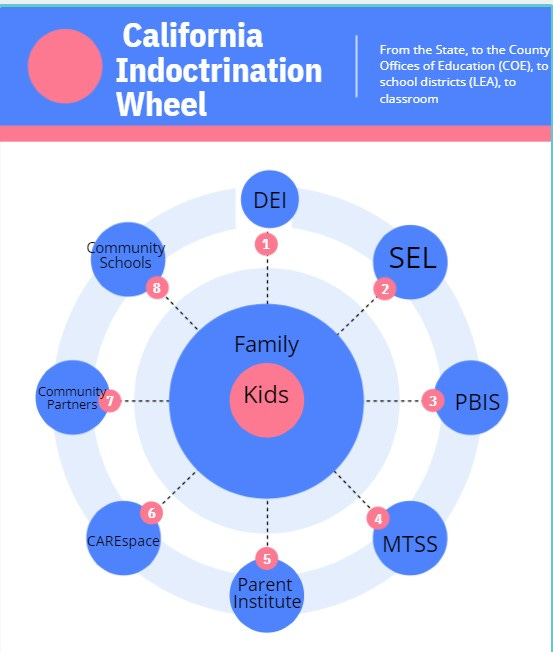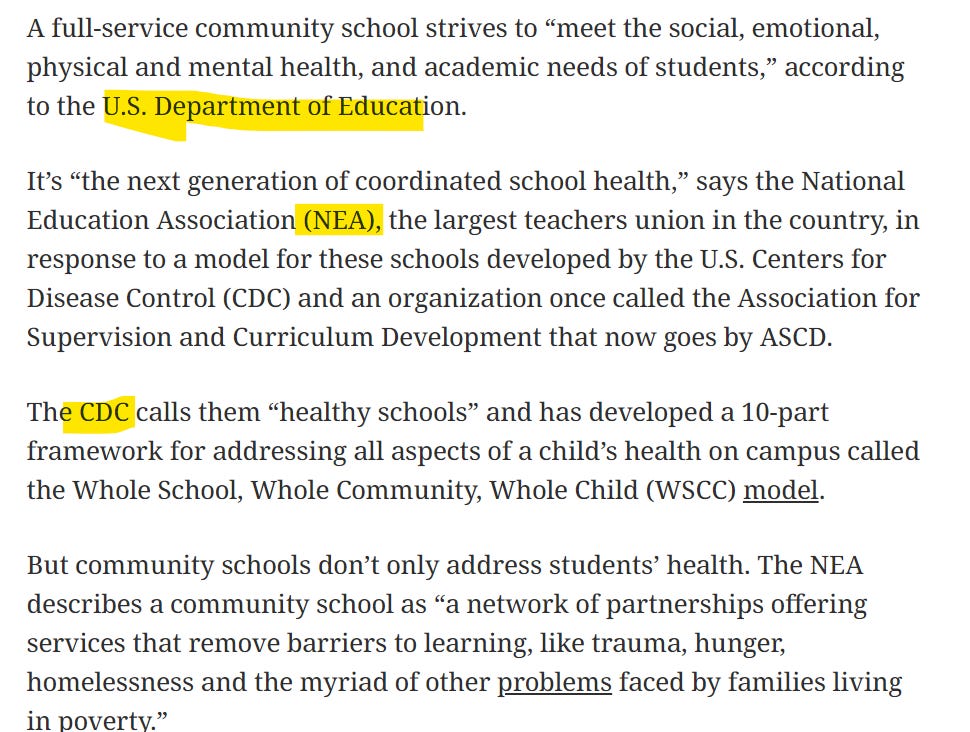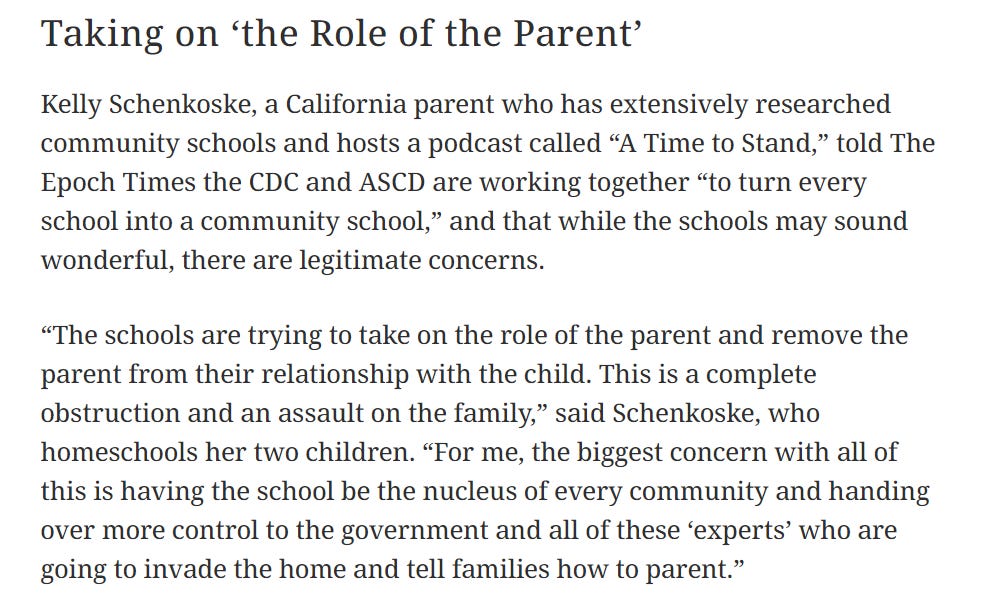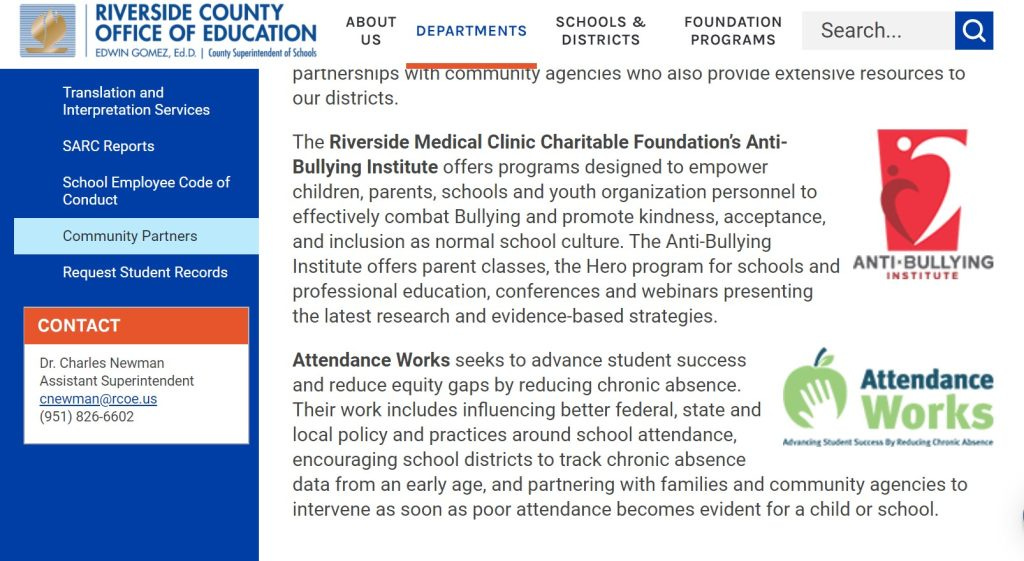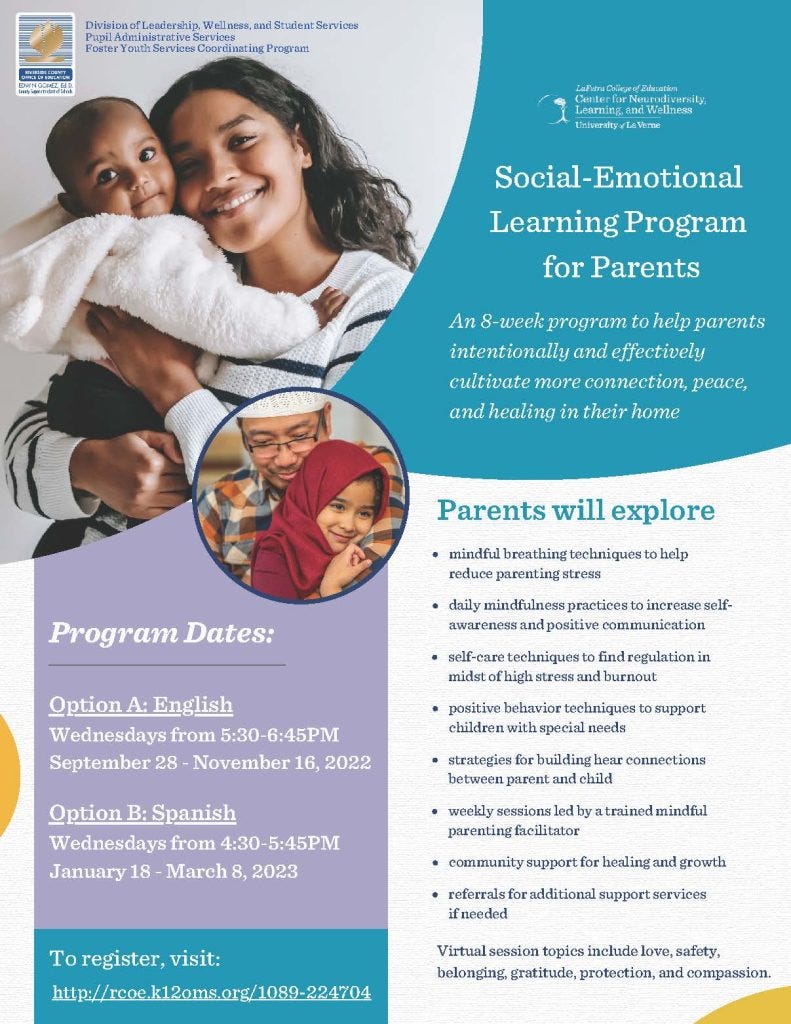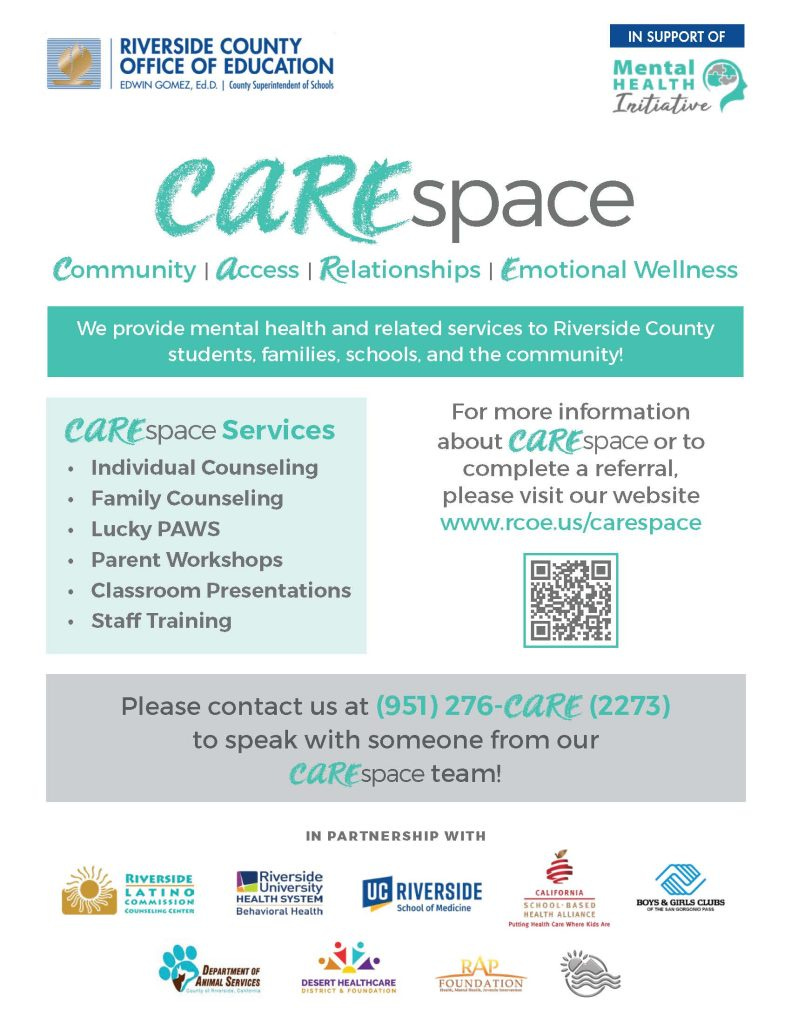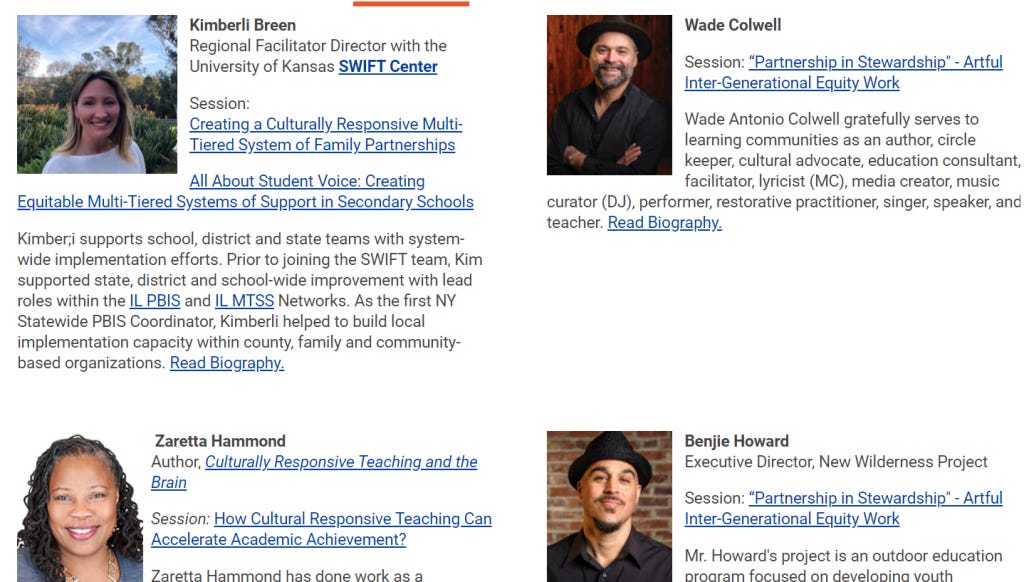The California Community Schools Blueprint For Whole Family Indoctrination
I am not the head of a Crime Family, but if I were, I would want control of the population that I used to enrich myself. I could use fear. Like jailing or suiciding anyone that disagreed with me, to make an example. Others would see what happens when you cross that invisible wall and say or do something contrary to my interests, and will be kept in check.
Or, if I wanted to play a longer game, I could convince the population what to think and how to think. I would start with activists in the schools, but quickly expand to influence the families as well. If I were particularly skillful, I could even convince them that my way of thinking is more important than their God-given freedoms, all the while enriching myself and my cronies. Those that go along with my scam will also benefit financially, even if it is just retaining employment.
Welcome to the long game: California Community Schools, Community Partners, and the California Community Engagement Initiative.
Branding the Community School
Those “community” phrases, by design (branding), evokes visions of the local community pitching in to assist in the skill building of students, skills students need in the real world. Thus, my expectation would be that the Community Partners are local retail and industrial businesses that would have an interest in a supply of a skilled and ethical labor source. Perhaps the Partners would offer on the job training, or even an internship for students, so they can learn the skills and/or the industry before they even hit the workforce. Does that make sense? A show of hands if you’re with me here.
If you raised your hand just now–and no, I did not see you as I am not the NSA or Facebook– I am sorry to disappoint you. In reality, the Community Schools and the Community Partners they procure are more in tune with propaganda and control, than teaching usable, real world skills. The Community Partners, for the most part, gain financially through more clients or grants. Unfortunately, the local business gain emotional wrecks that are dependent on the State, rather than a competent and ethical work force.
Therein lays the great con of California Community Schools, the bait and switch. The branding–sold to the State by special interests, which in-turn mandates to the County Office of Education (COE), who pass it on to local school districts (LEAs)– leads us to believe that the Community Partners are the businesses who will benefit through the labor force. Instead, the Community Partners largely benefit from our tax dollars.
Community Schools as Socialist Tools
An article recently appeared on DesertTruth in relation to the California budget education finance, which also described Community Schools, so if you’re new here you might want to backtrack to that link. Brad Jones, over at Epoch Times wrote this article last July that well describes how the Unions (NEA), the CDC, and the Department of Education view Community Schools.
Jones also provides warnings from parents and community members that have extensively researched Community Schools. Those warnings are that Community Schools are focused on Social Emotional Learning (SEL) and Equity; warnings that Equity is a re-branding of Socialism, and the goal of the State is to turn every school into a Community School.
These warnings are echoed in an Epoch Times commentary entitled “California Community Schools Are Socialist,” which posits:
“Under socialism, government is involved in everything: work, school, entertainment, even the home. That’s what California increasingly is becoming. Case in point: the “community schools” movement, which practically takes over all students’ lives, including that of their families.“
The warnings seem justified when considering the Riverside County Educator Equity pledge (strike-through/highlighting text mine).
The Community Engagement Con
Remember, California defines community schools in a way that infers true community engagement:
“A community school is any school serving pre-Kindergarten through high school students using a “whole-child” approach, with “an integrated focus on academics, health and social services, youth and community development, and community engagement.”
Indeed, everywhere we look, we may be inclined to infer that community engagement and community partners involve real world skills or knowledge. Furthermore, when we begin digging to uncover just who the Community Partners are in Community Schools, you will surely run across the Community Engagement Initiative (CEI), and then notice those terms get bandied and changed-up throughout the RCOE website.
CEI first appears on the scene in the 2018 education finance bill in the budget as AB 1808, section 140. AB 1808 called for the need of “meaningful stakeholder engagement, especially as it relates… and communities.” The fact that the purpose of the bill is for school districts to have “difficult conversations” with their communities is the first sign of the facade. Because before that, in (1) it mentions “meaningful stakeholder engagement…pupils, families, and communities….” By the time we reach the end of (4) however, community engagement is mentioned three more times, though it seems “communities” refers to the state agencies, county offices of education, and school districts.
Community engagement is mentioned in the current budget as well, to the tune of $100 million that can be used to pay “Partner Organizations“. But don’t worry, an agency was created to oversee all those taxpayer dollars, and they’ll explain everything.
Not the Partners We’re Looking For
To be clear, the CEI is not really related to what we set out to find, namely Community Partners of Community Schools. In fact, the communities referred to in the CEI, when not educational agencies, are intersectionality in nature, i.e. the “Black community,” the “Hispanic community,” the “LGBTQ community,” and the like, rather than the actual local community. The partnerships mentioned in the CEI are partnerships education agencies have with each other to discuss the best practices for bringing “equity” to their students. It seems logical to conclude then, that the $100 million in the budget “providing fiscal support to partner organizations” is really just a way to pay those agencies to meet with each other and share equity ideas. Or, to indoctrinate each other, depending on how you look at it.
Digging For Partners
An email to the RCOE requesting a list of Community Partners for Community Schools went unanswered. A similar email to San Bernardino office of Education was initially answered with the caveat “ [the] term “community partners” may mean something different for me than it does you,” and requesting to know the purpose behind the email. San Bernardino ignored the email as well, after learning the information was for this article.
Okay, so they left us to dig on our own. Let’s go, get the backhoe!
Searching the RCOE website reveals that RCOE created an entire department around community engagement, without mentioning anyone from the community, besides other educational agencies. But, this is not what we are looking for.
We do know one partner for Community Schools is through CAREspaces, The Latino Commission that specializes in drug rehabilitation. Edwin Gomez, RCOE superintendent justified having drug counselors provide mental health to “students, families, and the community” by reminding us that extraordinary times call for extraordinary measures. Are we in a Spider Man movie?
“In these extraordinary and unprecedented times, educating students requires extraordinary service and providing unprecedented support, and our collective focus on the social-emotional health of students and fellow educators has never been more important than it is right now,” said Riverside County Superintendent of Schools, Dr. Edwin Gomez. “Facilities and services like those offered inside each CAREspace are showing students that their educators see them, and hear them, and are here to help them succeed.”
“The Coachella Valley-based Latino Commission, has partnered with RCOE to provide mental health services for Riverside County students, families, schools, and the community.”
Edwin Gomez
Digging just a bit more, past the melodrama, reveals two more Community Partners, though these do not appear to be specific to Community Schools. The Anti-Bullying Institute, which actually appears to be non-woke and beneficial, at least at first glance. Attendance Works, on the other hand, will help schools reduce equity gaps by teaching schools better policies. Sure Jan.
Community Schools LCAPS and SARCS
Let’s do something a little different and take a visit to the RCOE 2022-23 Local Control And Accountability Plan (LCAP) for Community Schools. I know it sounds boring, but stay with me.
On page 33, we start to make progress in our quest and find a few partners. Though these partners are for the alternative education Career Technical Education (CTE) program, which are embedded with the Community Schools. Still, we’ll take what we can get.
When I ran a CTE program for Information Technology at a high school in Riverside, my community partners were a computer repair shop, a local hotel’s IT department, and a Nursing home (to help residences with tech). Each of those partners provided an internship for students to gain real life experiences. Just a note to establish expectations, which seem to be met on page 60 of the LCAP.
Wow, sounds not only good but also as it should be. But is it a facade? According to the 2021-22 School Accountability Report Card (SARC), only one student took a CTE course. So who are these Community Partners and what exactly do the do?
Back to the 2022-23 LCAP. Oh, $623,210 for Community Schools CTE pathways.
What’s in a Partner?
Let’s cross off the obvious–the probation department, the EDA, and the Riverside College District–and focus on the unknown. Cryoquip is a preexisting CTE partner for welding, which leaves the California Family Life Center (CFLC).
CFLC is a non profit thus receives funds from various sources and is certified by CARF. CARF provides international accreditation for rehabilitation facilities, even in China! Riverside County and the RCOE are two sources giving CFLC over 2.5 million, according to highergov.com. Another source, reported in the CFLC’s 2022 annual report, is Decker Brands who gave a $50,000 donation for “DEI racial and social justice giveback commitment.“
Community Schools Home and Family Intrusion
For those keeping score at home, we have thus far shown that the Community Partners for Community Schools seem to be focused on the “mental health” (indoctrination) of the students and their families. We have also discovered that those partners have a focus on equity, social justice, and social emotional learning rather than academics, personal responsibility, and real world skills.
The DEI/CRT method of achieving equity (again, indoctrination) chosen by the RCOE Community Schools are Universal Design for learning (UDL). Here are a couple of Substack articles if you need a UDL refresher.
Remember, it was posited that California wanted to turn every school into a Community School. The following are just a few of the pages encountered within the bowels of the RCOE in regards to family. Equity and SEL for the entire family! Some of these involve Community Schools, some do not.
Community Schools Signs of Success… for SEL
Heading back to the LCAP, we learn that 68% of students “show that they are on track in SEL…”
Well, isn’t that peachy-keen? With all that focus on equity, inclusion, diversity, and feelings, were they able to teach the students what they need to know to graduate? Oh, a 24% graduation rate and a 62% dropout rate would seem to indicate otherwise.
Beware of the Equity Bait and Switch
Due to the fact that everything we have seen is based on DEI and “equity”, it is only proper to issue a warning on the bait and switch. The video below is a good example of how education will use emotion to drown out critical thinking. Observe:
Take note that nothing we have seen thus far has dealt with special needs. Note also, that the Excellence Through Equity Training mentioned in that video had nothing to do with special needs either. Yet, RCOE saw fit to portray their equity visions in way to avoid questioning. Question this and you must hate special needs kids. To be sure, the video was great, but represents just a teeny-tiny fraction of what equity is in practice.
I have researched a few of the presenters seen in the conference pages below, and they are as horrid as we’ve come to expect. It would require another article to expose the extreme bias of the Excellence Through Equity conference presenters, but you can get a good idea from their session titles.
They Hunger
Is the State of California coming for your kids? It sure looks like it. Equity activists are embedded in California schools in the guise of administrators, teachers, and counselors. It does not appear the State’s hunger will be satiated with the kids either.
Recall we learned, in Stranger Danger and Stranger Danger II that there is a taxpayer funded push to utilize Medicaid to fund enough therapists that every student can see one regularly. Literally every student. It appears that every Social emotional arrow in the State’s equity quiver is aimed directly at your kids last defense. You.




